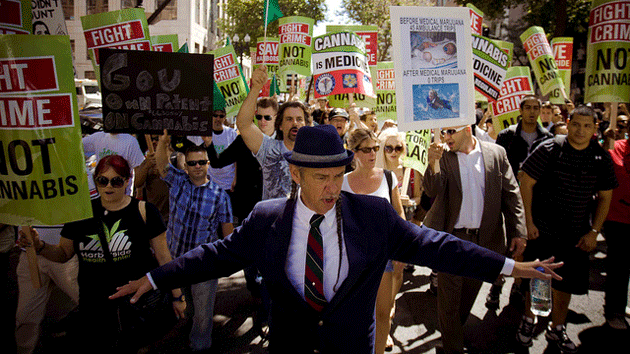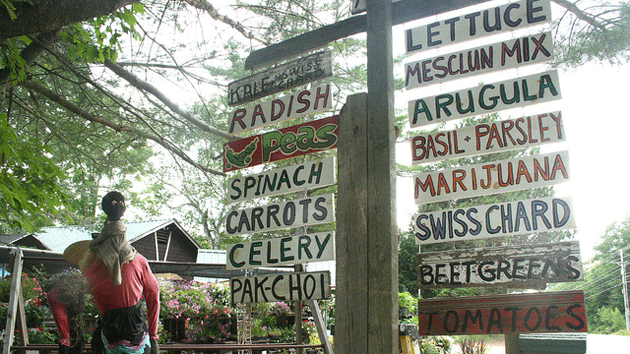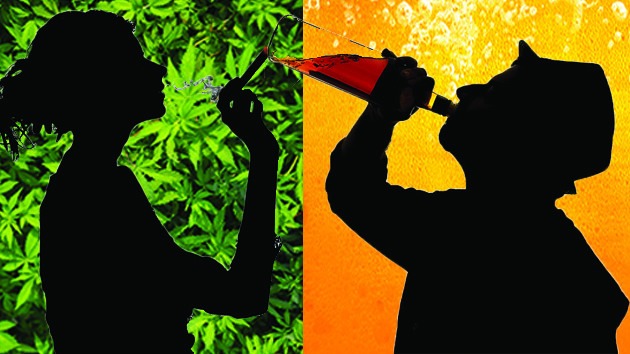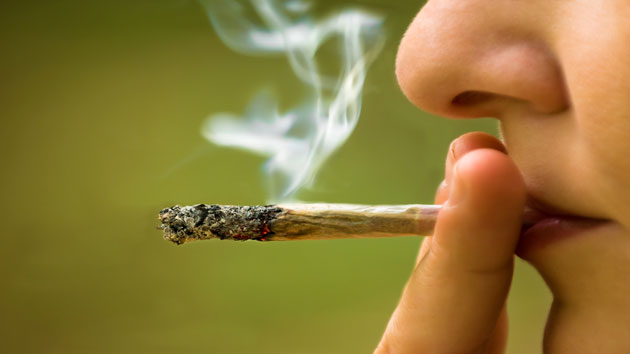
Steve DeAngelo at a protest in Oakland, California<a href="https://www.flickr.com/photos/ghalog/7635700844/in/photolist-atMmwd-atMmxW-82KGeG-atJFCn-atJFPK-atMn1y-atJFNe-atJFwZ-atMn3h-atMmzJ-atJFoa-atJFX4-8hSqCv-9k5rc1-cCJXQy-eSV67V-9WDpXX-9RHaxs-dE8Qxg-9vrJvf-pfH38M-7gNZEN-aqk9cq-aqhsDT-8oe51f-p7BNZh-p9DQCF-p7BNPh-p9BVZd-oSa6n9-oS9z2P-p9BVQq-oSa6Bs-drBhsg-7b6Ukb-p9ohmn-p7BPZJ-oSaCxH-p9oiGZ-oS9yUz-p9DQSZ-oS9yft-k4KF-9tbjRT-wyiQ-o6jDeQ-7Assgm-cTKkWb-eFV9TA-oCpQPs">Glenn Halog</a>/Flickr
Steve DeAngelo is best known as a lifelong cannabis activist and the founder of Oakland’s Harborside Health Center—California’s largest and, by many accounts, most respected pot dispensary. In 2012, US Attorney Melinda Haag initiated civil forfeiture proceedings against Harborside, which does $25 million a year in sales, on the grounds that it had grown too big. If the case goes to trial, DeAngelo has vowed to demand a courtroom large enough for “every single one of the 220,000 patients who depend on us for health care.” While maintaining an activist approach, DeAngelo has also become a leading pot entrepreneur as president of the Arcview Group investor network. His new book, the Cannabis Manifesto, will be published in September.
Mother Jones spoke with DeAngelo last week about his time as a teenage runaway, his experiences in the Yippies, and his predictions for the future of pot.
Mother Jones: When you were a teenager growing up in the DC suburbs in the early 1970s, your parents busted you for smoking pot and seized your stash. Then you ran away from home for a few weeks. How old were you?
Steve DeAngelo: Thirteen.
MJ: What would you tell your kids if they wanted to smoke pot?
SD: I don’t have kids so I am not in that situation, but I think one of the best ways for kids to learn about cannabis use is to see people who are close to them using it responsibly. If cannabis is not the forbidden fruit, teenagers are generally not that interested in it until they get to be 16, 17, 18 years old. Of course, I don’t advocate that anybody who is not legally qualified should use cannabis, but I do know that there are a lot of parents who share alcohol at the family table with their kids before they reach 18 or 21 years of age as a way of introducing responsible use to them. And I think that’s probably the most appropriate way for young people to be introduced to cannabis use.
MJ: You were later kicked out of school—twice—for smoking up, and arrested for smoking pot in a public park. Even so, you eventually graduated from college and became professionally successful. But that wasn’t true of your stoner friend Eddie, who was black. What happened?
SD: He lived over on the other side of town from me and ended up getting busted even more than I did. And he got different treatment. When the cops found me smoking weed in the park, they took my pipe away, dumped the weed out, and told me not to ever let them see me doing it again. When the school caught me being involved in cannabis transactions, they didn’t invite me to come back the next year.
When Eddie was found with weed, he was actually arrested and tried and sentenced and went to juvenile hall and was suspended from school. I didn’t see Eddie for a few years, and then when I finally ran into him again, he was working as a barback at Shepherd Park, which was the local strip club. He told me it was the only place he could find a job. The club later burned down, and a friend told me how Eddie had run in twice and pulled people out of the bar before he died in the fire.
MJ: This sort of discrimination still happens when it comes to pot. It happened to your employee Ricky McCullough.
SD: Ricky, like a lot of our staff at Harborside, has been asked to help in a lot of different gardens of different patients. He was watching a grow room in Hayward while the patient who owned it went on vacation. The door was ajar and when he came out there was a cop sitting there. Ricky showed the cop all the medical cannabis documentation which was hanging up in the garden, his own medical cannabis documentation, and his ID. He didn’t have any weapons on him and was in 100 percent compliance with California medical cannabis law, but he was arrested and taken down to Santa Rita Jail.
These cases usually go nowhere—as soon as the employee demonstrates their medical cannabis status, the charges are dropped. But that didn’t happen with Ricky. We had to fight tooth and nail for over nine months before they would release him. The main reason he was treated that way was because his name was McCullough—some of his cousins had previous run-ins with the police—and maybe just because he was black.
MJ: Your parents were civil rights activists. Did they see drug policy reform as a civil rights issue?
SD: No [laughs]. I had a serious conflict with my parents around cannabis and that conflict, at least in the case of my father, really didn’t get finally resolved until I was granted a dispensary license by the city of Oakland. But the bottom line is that the racial disparity in cannabis enforcement that we hear so much about is not an unintended consequence of prohibition. It was the primary purpose of the cannabis laws in the first place. The first state laws prohibiting cannabis were passed in 1911, 1912, 1913, in border states, and it was a response to the influx of Mexican refugees who were bringing cannabis with them because it was part of the native curandero healing tradition in Mexico—they used it as a folk medicine. If you go back and read the comments of the legislators who passed those laws, you will see there was a very clear, and by today’s standards completely unacceptable, racism that was motivating that. And that simply got transferred as cannabis use became popular in the African-American community and moved across the country through the jazz scene. So when you look at it in that context, and at the number of African-Americans who have been arrested and had their property taken away, you see that cannabis prohibition has been a very powerful tool of racial repression.
MJ: Despite your parents’ dislike of cannabis, your mother later used it to treat her anxiety. What caused her to come around?
SD: I think it was mainly because she was surrounded by some friends who had positive attitudes about cannabis. After she got Alzheimer’s, which was during the time I was writing the book, it became really critical to her health care. She would experience extreme distress. I would be sitting working or reading and I would hear this long horrible wail of despair. The more I would try to calm her down, the more agitated she would get. So naturally I tried cannabis and it was tremendously effective for her. It just instantly brought her relief and made her more communicative.
MJ: In California there are doctors who for a few bucks will give pot recommendations to pretty much anyone for any reason. I got one for writer’s cramp. But you argue in your book against drawing a bright line between pot’s medical and recreational uses.
SD: It’s all about wellness. And I define wellness broadly. Certainly it includes extreme medical situations, but I also think it includes things like waking up your sense of play, improving an intimate experience, or enhancing the flavor of food.
MJ: After dropping out of school, you joined the Yippies, a group that among other things smoked and sold a lot of pot. What did you learn?
SD: I learned to be very suspicious of ideology and dogma and political leadership. The Yippies theoretically were supposed to be an anarchist, nonauthoritarian grouping, but in fact there was a whole system of hidden power structures and economic structures that underlay the organization. So I learned it was very important to be suspicious of the idea that there could be a revolution that was going to solve all our problems all at once.
MJ: Which was quite a popular notion back then.
SD: Hey, I was ready for the Weather Underground to come hand me an AK-47 when I was in high school. We were ready for the revolution. But it wasn’t until I went to Eastern Europe a decade later and saw first hand the consequences of communism that I really lost all my vestiges of respect for a Marxist kind of economy.
MJ: So would you now call yourself a libertarian?
SD: My experiences with the federal government have caused me to be very suspicious of them, and in general to favor a leaner federal government rather than a heftier one. That said, I believe income inequality is an issue that is critical for us to address. I am this weird sort of guy. I often find it difficult to endorse any party or politician.
MJ: In the DC area you ran a countercultural gathering place called the Nuthouse. It sounds like you had a good time.
SD: When George H.W. Bush went to war in Kuwait, the Nuthouse was a staging ground for what we called Beat Around the Bush. On the night of the war, a bunch of us went down in front of the White House and started a drum circle, pounding it out all night long. After that, there were people drumming in the park constantly throughout the entire war. Bush made a comment, captured in the Washington Post, saying, “Those damn drums are keeping me up all night long.” Which of course we immediately printed up on a T-shirt and proudly distributed.
MJ: During the Nuthouse days, you helped launch the hippie craze for hemp jewelry.
SD: I was part of a group of cannabis activists that would do these hemp teach-in sort of things at college campuses, talking about how it’s this amazing forgotten product that has been outlawed. We wanted to show people old stuff made from hemp but had a really hard time locating things. Then I found this company in Philadelphia that had three tons of 100 percent hemp twine, which had been ordered from Hungary in 1955. It was delivered just as the Hungarian revolution broke out, and for political reasons the Navy, which had ordered it, never accepted delivery.
So the twine had been sitting in the warehouse of this company ever since. We got some balls of this twine, just stunning, and put it into our hemp museum. Kids at colleges started offering to buy the twine from the museum. And at first we were like, this sounds like a hassle, but enough people started asking for it that it became obvious there was a demand. We started getting larger orders of the twine from the company and actually selling them as a fundraising tool. And the orders got bigger and bigger. Finally we realized it was the perfect macramé material, so that’s how the macramé hemp jewelry fad started. Before long, we had a company called Ecolution that was brining in container loads of that twine. Amazingly, the same Hungarian company was still around, and they were very happy to see that there was demand from the United States again.
MJ: Clearly, market forces are changing the marijuana industry. I wonder if you ever worry that with the mainstreaming of cannabis, the culture of pot smoking will lose its bohemian and activist roots—that pot is going the way of tech bros and Super Bowl ads.
SD: Yeah, I worry about it, but I also know that it’s what we set out to do. My agenda has been to protect people who care about and use cannabis because I am one of them. But also because I’ve believed from the very beginning that if more people start using more cannabis and less alcohol and less tobacco and less pharmaceuticals, then we are going to be in a world that is more tolerant, more peaceful, that is in a better equilibrium with nature, that has a better reverence for creativity, that understands that fun and love are important parts of life. It was never about creating a small little isolated culture that was going to percolate on its own. We wanted to change the world. So I’m actually thrilled to see cannabis being mainstreamed. And it’s my belief that at the end of the day, cannabis is going to influence mainstream culture more than mainstream culture is going to influence the plant.
MJ: Harborside has certainly influenced things. The federal case against your dispensary continues, but now you have some powerful politicians on your side, including Democratic Sen. Barbara Boxer and Republican US Rep. Dana Rohrabacher, who visited you recently. What caused them to finally get involved?
SD: There’s a large part of the American public that just doesn’t believe the propaganda anymore. They have enough direct, firsthand experience with it to be more open-minded. And that is being reflected in changes by the politicians. I think the election victories in 2012 and 2014 were really critical to demonstrating to politicians that embracing cannabis could be more of a win than a loss. With Barack Obama and the Democrats in the White House, it has also become easier for some Republicans like Dana Rohrabacher to be able to oppose some of their policies around cannabis. He has been tremendously successful in the Republican Party organizing cannabis reform around the principle of states’ rights.
MJ: How would legalization in California affect Harborside?
SD: I think what we want to avoid is the kind of system they have in Colorado, which is insane. You go into a cannabis shop and they have a wall down the middle of it. On one side there’s what they call recreational, and on the other side there’s what they call medical. You can have exactly the same products on both sides, the only real difference is you pay less tax on the medical side. But you have to maintain a separate entrance and exit, a separate staff, and a separate inventory for the medical and recreational sides. And that’s caused a huge amount of unnecessary duplication of effort. I hope we don’t do that.
MJ: You’re now involved with groups that invest in the pot sector. Is big business just going to take over the industry?
SD: I don’t think big business is going to take over the industry entirely, but it is certainly going to play a role just like it does in any other large-scale industry in this country. What I envision is a multitiered marketplace. There are lots of consumers who are going to be attracted to paying a half or a third as much as they do now for cannabis, and won’t be particularly bothered that it is produced in semi-industrial factory circumstances with commercial inputs and semiskilled labor under lights. And there’s going to be other consumers who will be happy to pay more and get something that is cultivated organically by a master gardener in a small plot. We need to make sure the regulations create an equal playing field for all these different models.
MJ: In your book, you anticipate the day where restaurants serve cannabis lozenges in the same manner as wine pairings. Is this actually going to happen anytime soon?
SD: The question is: When will we have a level of social acceptance that makes that kind of distribution acceptable? When you think about cannabis as an intoxicant, the idea of having lozenges on airplanes and in museums and other fairly public types of environments starts to shift to maybe being disturbing to people. So critical to that kind of acceptance will be popularizing the idea of cannabis as a wellness product.
MJ: What does the future of pot look like in California?
SD: You need to look ahead to the day that those interstate barriers to legal cannabis commerce drop. I think California will become the low-cost, high-quality supplier of cannabis to most of the rest of the country and a good chunk of the rest of the world. We have some natural advantages. First, right now we are the largest legal market for legal cannabis in the world. That gives us an opportunity to build larger companies, bigger teams, more talent and sophistication, stronger brands than any other state would be able to do. We also have the perfect microclimates for growing cannabis outdoors or in greenhouses, which means we can produce a higher quality cannabis at a lower cost than any other place in the country, hands down.
Third, we have incredible existing Big Ag infrastructure. We have those greenhouses, the aquifers, the wells, people at UC-Davis who have been working on tweaking the shape of lettuce leaves for 20 years, and who will be able to do incredible things with cannabis when they get their hands on it. We have a fairly supportive political structure, and we have a greater aggregation of cannabis expertise and genetics than anyplace else on the planet. We are looking at a nationwide market of about $150 billion a year, at least. California, I think, could claim half of that.
MJ: That would be more than the value of all of the state’s agricultural commodities combined.
SD: Yes, it probably would.


















